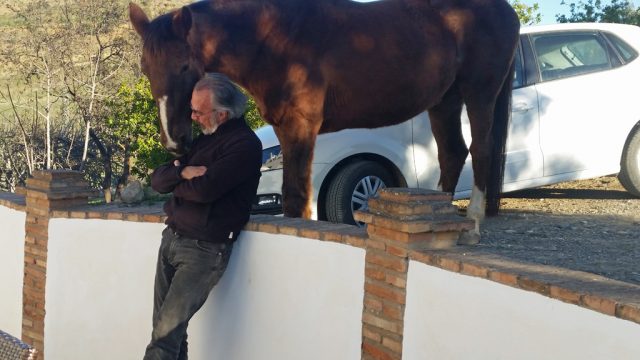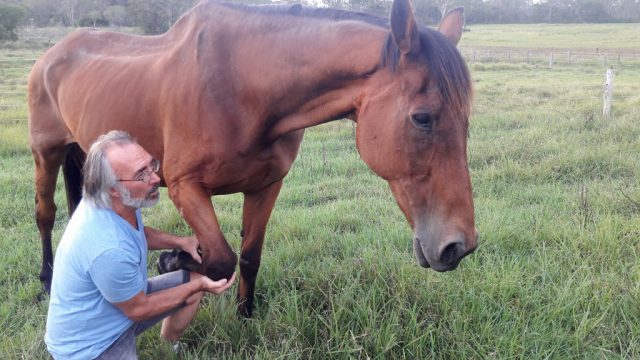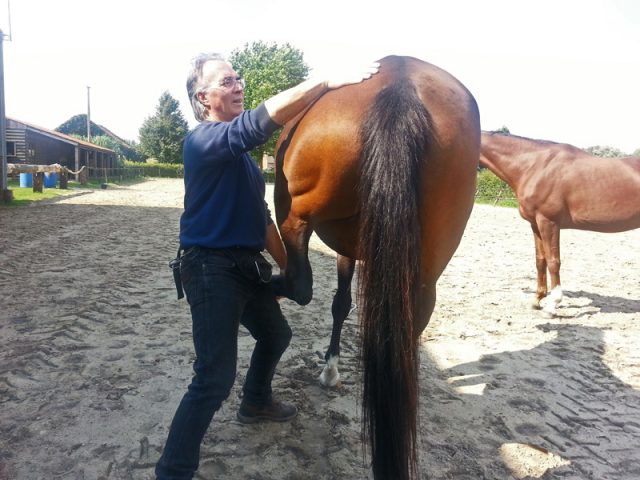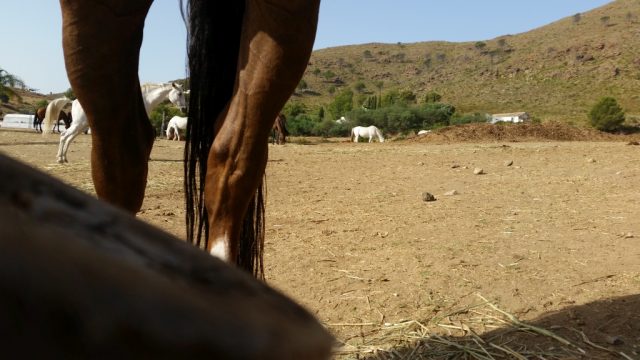When a horse enters our life, one of the very first things we think of is training. I have gone on record as someone who believes that we grasp at the crutch of training long before we give contact, connection and communication an opportunity to create a strong bond of understanding between horse and human. Yet I readily acknowledge that there are times when training, as in the conditioning of a horse’s behaviour, may be required. Positive reinforcement is the method of choice when this is the case for it makes it possible for both the human and the horse to experience the joys of voluntary, spontaneous interaction between them outside the confines of training. Yet, and this may come as a surprise to many, positive reinforcement also carries within it the seeds of danger to the horse, the human, the relationship between them and other humans. So just what are these joys and dangers? And can the dangers be avoided to exploit positive reinforcement for truly creative communication between horse and human?
The joys: highly effective training
In the very first place, positive reinforcement – I am assuming that you are familiar with positive reinforcement training but, if you need to brush up, please see my article titled ‘Horse Training: Living the Dream or Creating an Illusion?’ in my book, When Horses Speak and Humans Listen (http://www.horsesandhumans.com/mainsite/whsahl-a.htm) – is arguably the most effective form of behavioural (involving behaviour) or behaviourist (of the school of behaviour modification) horse training. Using this method it is possible to train (condition) horses to reproduce modified (conditioned) behaviour in response to a trigger. It is also possible to do so within a relatively short space of time.
Like all training involving the conditioning of behaviour, this type of training depends on repetition and reinforcement for its success. In the case of positive training repetition is secured with the aid of a treat, at least initially. Once such conditioned behaviour is trained, it is possible for a human to elicit it from the horse merely by activating the trigger that has been trained. Various studies have shown that positive reinforcement is a far more effective form of behaviourist training than the negative reinforcement approach normally employed in conventional and ‘natural horsemanship’ training (although the latter has shown itself to be very effective – often to the point of being destructive – where it also involves psychological manipulation).
The joys: helping a horse
Positive reinforcement training is particularly useful to enable a human to approach a ‘difficult’ horse in order to help them. I have personally seen a friend use it to help a semi-feral horse that required assistance with general, health and hoof care. While it may be possible to achieve the same through contact, connection and communication, in some instances the urgency of the situation may require prompt action. In such a case positive reinforcement can be a great help.
The joys: the creation of beauty
Because positive reinforcement is such a highly effective method of training when done properly, it is possible for a human to train fairly complex forms of behaviour. For instance, a human can train a horse to pick up and do something with an object, such as a ball or even a letter of the alphabet. This can even be extended to teaching the horse to associate words and colours with an object or even a pattern of letters depicting a word. Positive reinforcement can also be used to train advanced riding and even haute ecole techniques.
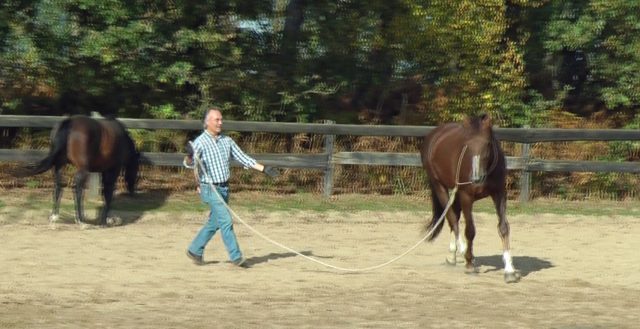
Although Pip and I are linked by a lead, I have less control over her than alone at liberty with a whip in a small picadero.
In the hands of a capable positive reinforcement trainer, the results of such training can be quite spectacular to see. I have seen horses trained using positive reinforcement reproduce playful behaviour with balls and traffic cones, amongst other things. I have been astounded by horses reproducing the behaviour required to answer their human’s whistle by galloping up to them. I have admired the graceful dressage movements horses are able to reproduce in response to an almost invisible trigger. I have even marvelled at a horse being able to spell a word with cut-out letters in response to a question requiring them to make a choice. In short, the results of positive reinforcement behaviour modification can be amazing.
The joys: usually no barrier to the horse-human bond
If training is required, perhaps the single most important secondary benefit of the positive reinforcement approach lies in the fact that it does not usually pose an obstacle to the development of a close bond between the horse and the human. Horses and humans are sentient beings and, as such, the development of such a relationship is contingent on them being able to express themselves voluntarily and spontaneously in relation to each other.
With its reliance on tools of control and instruments of coercion, negative reinforcement training may create barriers to such voluntary, spontaneous interaction. This is because the horse learns to associate unpleasant experiences with the trainer. Positive reinforcement training does not suffer from this severe limitation. Outside of the actual training and the reproduction of trained behaviour, voluntary, spontaneous interaction between horse and human remains possible. As a result, it is possible to pursue this type of training without adversely affecting the relationship between horse and human.
The dangers: no voluntary, spontaneous interaction
Yet we need to be aware that the horse has little or no control over their actions while reproducing conditioned behaviour. This is because such behaviour is largely automated. When the trigger is activated, the horse reproduces the conditioned behaviour largely involuntarily and never spontaneously. As a result, the interaction between the human and the horse is also involuntary and anything but spontaneous while such behaviour is reproduced. Quite simply, while it is exhibited, conditioned behaviour precludes the voluntary, spontaneous interaction between sentient beings by its very nature.
The dangers: self-delusion
Yet this is not always obvious to the human. Because the behaviour that we train is almost inevitably pleasing to us, it can sometimes become difficult for us to distinguish between behaviour of the horse that is a spontaneous expression of their will and that which is a largely mindless response to a trigger. More importantly, there is a profound temptation to embrace the conditioned behaviour and interpret it as a voluntary response on the part of a sentient being because it suggests that the horse is actually doing what we have asked them to do of their own accord, even though it is clear that this is not the case.
The dangers: deceit
Over the years I have also seen some instances of positively reinforced conditioned behaviour being used to deceive other humans either intentionally or unintentionally. Frequently this takes the form of an image or video showing a horse executing a stunning move or sequence of moves against an attractive backdrop. Horse and human appear to display an enviable degree of connection and communication with each other. Yet, if the truth be known, the horse is merely responding to the cues and rewards of their human. What is portrayed is a hollow pantomime of the real deal. Where this occurs as part of campaign to woo other humans to part with their hard-earned money to learn how to achieve genuine communication and connection – spontaneous and voluntary – with a horse, it would be difficult not to conclude that this is fraudulent.
The dangers: stress
How can positive reinforcement possibly elicit stress in a horse? After all, does it not rely on a positive reward for the purposes of repetition and reinforcement, and does that reward not usually or often involve a treat for the horse? Yes, it does but therein lies the potential for occasioning stress in the horse.
On a number of occasions I have witnessed a horse queuing for positive reinforcement training. As the trainer completes an activity with one horse and moves a head closer to the subject of observation, the latter begins to exhibit signs of stress. The neck and muzzle tighten, the eyes constantly flick towards the trainer, they become agitated, and they start to salivate.
The dangers: undesirable behaviour
The example that readily springs to mind in this respect is that of our mare, Anaïs, when Vicki was trialling positive reinforcement with her. The mare was keen and intelligent. She learned fast but more extensively than envisaged. Anaïs soon understood that exhibiting the desired behaviour elicited a reward, so she decided to do just that even when such behaviour was not sought. She would perform what she had learned and then demand her reward. Vicki quickly abandoned positive reinforcement and began to focus on connection and communication rather than behaviourist training.
The dangers: a failure to acknowledge the dignity of the horse
Although there are times when positive reinforcement can be a great help to both horse and human, there are others when any form of training would not really be required, if we were to focus more on our own self-development, physical, mental and emotional. Horses are extremely sensitive creatures. Not only are their physical senses far superior to ours in many, if not most, respects, they are also masters at detecting subtle shifts of energy.
The story of Clever Hans (see https://en.wikipedia.org/wiki/Clever_Hans) is a particularly revealing one in this connection. Such sensitivity and capacity to respond in kind, surely this is deserving of honour and respect? Is it not something that we should nurture? Bearing this in mind, if we do not do so, if we were to insist on positive reinforcement training or the activation of the fruits of that training where a reliance on connection and communication would suffice, would this not amount to a failure on our part to acknowledge the dignity of the horse? And how much in the way of close connection would we not miss if we were to be guilty of such failure? Do we really want this?
Potential for creative communication
With the aid of positive reinforcement, horses have been successfully trained to exercise choice by distinguishing between shapes and colours. What holds even greater promise is the success with which positive reinforcement has been used to enable horses to express and communicate a preference to humans using symbols. An example of this is a Norwegian study conducted in 2016 which showed that horses were capable of doing so in a highly controlled environment with exceedingly limited choice – ‘rug on, rug off’ (see https://www.sciencedirect.com/science/article/pii/S0168159116302192).
See this post for more info about this video: At the Interface of Horse-Human Interaction
In this sense colours, shapes and symbols are used as building blocks of communication, similar to the function of words in our linguistic communication with each other. It is in this direction that I feel positive reinforcement has great potential. Instead of using it to elicit controlled behaviour, however elaborate, why not focus on empowering the horse to express choice in response to a human question? And the next qualitative leap that we might hope for after that is that our horses learn to express choice – as they currently can if we are listening – but now employing such building blocks to extend the field within which they are capable of doing so. Imagine if your horse could come up to you while hanging out with them holding their red halter in their mouth (because you had taught them how to distinguish between red and other colours and between the shape of a halter, grooming brush, hoof pick and the like for this purpose) and then walk towards the exit to the forest trail before turning around to wait for you to catch up and express your choice? The possibilities could be endless, couldn’t they?
Note
Some of the illustrations depict interaction between a horse and a human which could be downright dangerous if attempted in the absence of mutual trust, connection and communication. Please bear this in mind if you contemplate replicating such interaction.
Equine Touch
Our Equine Touch business is called Humans for Horses, you can find our website at:
http://www.humansforhorses.com/
and our Facebook page at:
https://www.facebook.com/Humans.for.Horses
Horses and Humans on Facebook
May I remind you that we now have a Horses and Humans group on Facebook. If you would like to leave a comment, you can do so on this blog or on the the Horses and Humans Facebook group page. All new posts will feature on that page along with additional content posted by any of our members. Please feel free to join us at:
https://www.facebook.com/groups/horsesandhumans/
There is also a Horses and Humans publications page, which contains information concerning the publications released under the Horses and Humans imprint. Some of those publications will be free of charge. You will find it here:
https://www.facebook.com/horsesandhumans
I also have a Facebook page through which you may contact me. You will find it at:
https://www.facebook.com/andrewglynsmail

